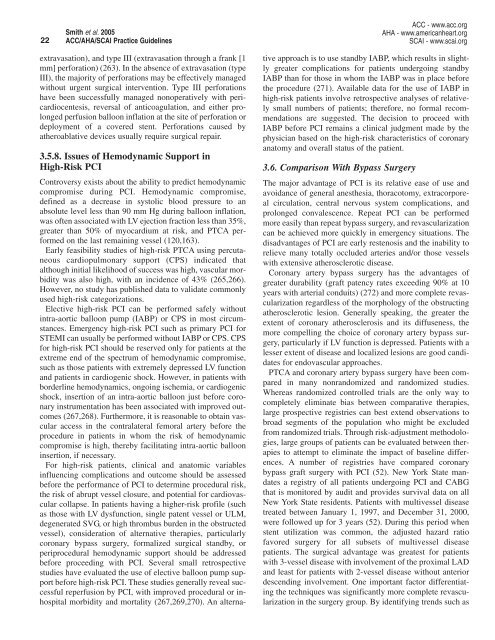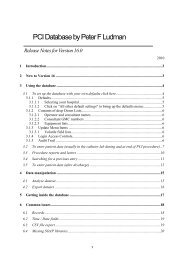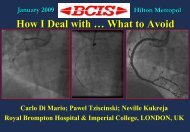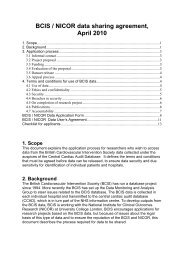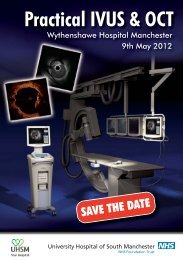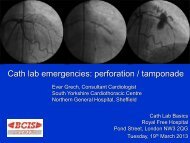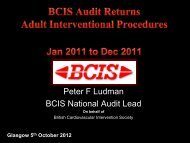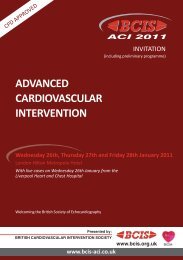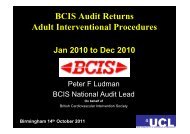Recommendations
ACC/AHA/SCAI PCI Guidelines - British Cardiovascular Intervention ...
ACC/AHA/SCAI PCI Guidelines - British Cardiovascular Intervention ...
- No tags were found...
Create successful ePaper yourself
Turn your PDF publications into a flip-book with our unique Google optimized e-Paper software.
22<br />
Smith et al. 2005<br />
ACC/AHA/SCAI Practice Guidelines<br />
ACC - www.acc.org<br />
AHA - www.americanheart.org<br />
SCAI - www.scai.org<br />
extravasation), and type III (extravasation through a frank [1<br />
mm] perforation) (263). In the absence of extravasation (type<br />
III), the majority of perforations may be effectively managed<br />
without urgent surgical intervention. Type III perforations<br />
have been successfully managed nonoperatively with pericardiocentesis,<br />
reversal of anticoagulation, and either prolonged<br />
perfusion balloon inflation at the site of perforation or<br />
deployment of a covered stent. Perforations caused by<br />
atheroablative devices usually require surgical repair.<br />
3.5.8. Issues of Hemodynamic Support in<br />
High-Risk PCI<br />
Controversy exists about the ability to predict hemodynamic<br />
compromise during PCI. Hemodynamic compromise,<br />
defined as a decrease in systolic blood pressure to an<br />
absolute level less than 90 mm Hg during balloon inflation,<br />
was often associated with LV ejection fraction less than 35%,<br />
greater than 50% of myocardium at risk, and PTCA performed<br />
on the last remaining vessel (120,163).<br />
Early feasibility studies of high-risk PTCA using percutaneous<br />
cardiopulmonary support (CPS) indicated that<br />
although initial likelihood of success was high, vascular morbidity<br />
was also high, with an incidence of 43% (265,266).<br />
However, no study has published data to validate commonly<br />
used high-risk categorizations.<br />
Elective high-risk PCI can be performed safely without<br />
intra-aortic balloon pump (IABP) or CPS in most circumstances.<br />
Emergency high-risk PCI such as primary PCI for<br />
STEMI can usually be performed without IABP or CPS. CPS<br />
for high-risk PCI should be reserved only for patients at the<br />
extreme end of the spectrum of hemodynamic compromise,<br />
such as those patients with extremely depressed LV function<br />
and patients in cardiogenic shock. However, in patients with<br />
borderline hemodynamics, ongoing ischemia, or cardiogenic<br />
shock, insertion of an intra-aortic balloon just before coronary<br />
instrumentation has been associated with improved outcomes<br />
(267,268). Furthermore, it is reasonable to obtain vascular<br />
access in the contralateral femoral artery before the<br />
procedure in patients in whom the risk of hemodynamic<br />
compromise is high, thereby facilitating intra-aortic balloon<br />
insertion, if necessary.<br />
For high-risk patients, clinical and anatomic variables<br />
influencing complications and outcome should be assessed<br />
before the performance of PCI to determine procedural risk,<br />
the risk of abrupt vessel closure, and potential for cardiovascular<br />
collapse. In patients having a higher-risk profile (such<br />
as those with LV dysfunction, single patent vessel or ULM,<br />
degenerated SVG, or high thrombus burden in the obstructed<br />
vessel), consideration of alternative therapies, particularly<br />
coronary bypass surgery, formalized surgical standby, or<br />
periprocedural hemodynamic support should be addressed<br />
before proceeding with PCI. Several small retrospective<br />
studies have evaluated the use of elective balloon pump support<br />
before high-risk PCI. These studies generally reveal successful<br />
reperfusion by PCI, with improved procedural or inhospital<br />
morbidity and mortality (267,269,270). An alternative<br />
approach is to use standby IABP, which results in slightly<br />
greater complications for patients undergoing standby<br />
IABP than for those in whom the IABP was in place before<br />
the procedure (271). Available data for the use of IABP in<br />
high-risk patients involve retrospective analyses of relatively<br />
small numbers of patients; therefore, no formal recommendations<br />
are suggested. The decision to proceed with<br />
IABP before PCI remains a clinical judgment made by the<br />
physician based on the high-risk characteristics of coronary<br />
anatomy and overall status of the patient.<br />
3.6. Comparison With Bypass Surgery<br />
The major advantage of PCI is its relative ease of use and<br />
avoidance of general anesthesia, thoracotomy, extracorporeal<br />
circulation, central nervous system complications, and<br />
prolonged convalescence. Repeat PCI can be performed<br />
more easily than repeat bypass surgery, and revascularization<br />
can be achieved more quickly in emergency situations. The<br />
disadvantages of PCI are early restenosis and the inability to<br />
relieve many totally occluded arteries and/or those vessels<br />
with extensive atherosclerotic disease.<br />
Coronary artery bypass surgery has the advantages of<br />
greater durability (graft patency rates exceeding 90% at 10<br />
years with arterial conduits) (272) and more complete revascularization<br />
regardless of the morphology of the obstructing<br />
atherosclerotic lesion. Generally speaking, the greater the<br />
extent of coronary atherosclerosis and its diffuseness, the<br />
more compelling the choice of coronary artery bypass surgery,<br />
particularly if LV function is depressed. Patients with a<br />
lesser extent of disease and localized lesions are good candidates<br />
for endovascular approaches.<br />
PTCA and coronary artery bypass surgery have been compared<br />
in many nonrandomized and randomized studies.<br />
Whereas randomized controlled trials are the only way to<br />
completely eliminate bias between comparative therapies,<br />
large prospective registries can best extend observations to<br />
broad segments of the population who might be excluded<br />
from randomized trials. Through risk-adjustment methodologies,<br />
large groups of patients can be evaluated between therapies<br />
to attempt to eliminate the impact of baseline differences.<br />
A number of registries have compared coronary<br />
bypass graft surgery with PCI (52). New York State mandates<br />
a registry of all patients undergoing PCI and CABG<br />
that is monitored by audit and provides survival data on all<br />
New York State residents. Patients with multivessel disease<br />
treated between January 1, 1997, and December 31, 2000,<br />
were followed up for 3 years (52). During this period when<br />
stent utilization was common, the adjusted hazard ratio<br />
favored surgery for all subsets of multivessel disease<br />
patients. The surgical advantage was greatest for patients<br />
with 3-vessel disease with involvement of the proximal LAD<br />
and least for patients with 2-vessel disease without anterior<br />
descending involvement. One important factor differentiating<br />
the techniques was significantly more complete revascularization<br />
in the surgery group. By identifying trends such as


